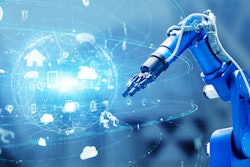
As the pandemic is still a live threat in many areas of the world, the supply chain continues to experience disruption on a large scale. This, combined with safety concerns, results in many customers opting for online delivery rather than shopping in brick-n-mortar stores. The continued rise in demand for next-day delivery has put more pressure on businesses. These turbulences have forced the entire supply chain to evolve rapidly, bringing the supply chain away from functional orientation and toward a global and interconnected network of data and processes.
The reshaped supply chains of the future are characterized by both resilience and cutting-edge technologies like artificial intelligence (AI), Internet of Things (IoT) and delivery automation. New technologies like these are being merged into the digital supply network, which integrates data and information from different sources to drive distribution of manufactured goods along the value chain.
Artificial intelligence
AI in supply chains is helping deliver powerful optimization capabilities required for more accurate capacity planning, improved productivity, higher quality, lower costs and greater output, all while fostering safer working conditions. According to McKinsey, 61% of manufacturing executives report decreased costs, and 53% report increased revenues as a direct result of introducing AI into their supply chain.
AI enables better supply chain operations with:
● Accurate inventory management
AI systems with intelligent algorithms can predict and discover new consumer habits and forecast seasonal demand. This application of AI helps anticipate future customer demand trends while minimizing the costs of overstocking unwanted inventory.
● WMS efficiency and safety
AI-based automated tools can ensure smarter planning and efficient warehouse management, which can enhance worker and material safety. AI can analyze workplace safety data and inform manufacturers about any possible risks. AI-driven automation efforts can significantly reduce the need for and cost of warehouse staff.
● Location intelligence
AI can provide a comprehensive view of all parts of the supply chain, and most importantly, allows personnel to know what is happening, and where, in real-time. For instance, a giant container vessel, the Ever Given, was stuck in the Suez Canal, blocking all cargo transportation through the canal. The Ever Given was freed after six days, but experts warn the impact on the supply chain could last for months to come. In this situation, location intelligence can be enabled, and the digital supply chain model can adapt to the dramatically increased event-detection with speed and accuracy to minimize the supply chain disruption.
IoT
IoT devices have revolutionized supply chain management. IoT devices can be attached to storage containers or shipments of raw materials and products. This enables people to track the movement of goods using GPS when the IoT device transmits its location.
With an IoT inventory system, the supply levels of several critical elements can be monitored in real time to help inform business decisions and prevent shortages. The data from these systems can even be analyzed to predict the future inventory needs of the business.
The most prominent impacts of IoT in supply chain are:
● Real-time location tracking of inventory
● Storage condition monitoring
● Forecasting the movement and arrival of goods
● Improving contingency planning
By 2022, Gartner predicts that more than half of major new business processes will incorporate some element of IoT. According to Forrester, 58-77% of surveyed organizations consider locating objects, containers and personnel as the top fundamental functions of IoT solutions.
Delivery automation
From customer service to the warehouse, automated intelligent operations can work error-free for a longer duration, reducing the number of errors and workplace incidents. Warehouse robots provide greater speed and accuracy, achieving higher levels of productivity and removing operational bottlenecks along the value chain with minimal effort to achieve delivery targets.
Tractica Research estimates that the worldwide sales of warehousing and logistics robots will reach $22.40 billion by the end of 2021. Robots are locating, tracking and moving inventory inside warehouses, they are conveying and sorting oversized packages at ground distribution hubs.
OKRs in supply chain execution
Organizations are accelerating their digital transformations while logistics businesses are starting to introduce capabilities like real-time order monitoring, end-to-end inventory visibility and super-reverse logistics experiences. Leaders must remain committed to eliminating barriers and increasing collaboration across competitive and industry lines to find solutions that will benefit all stakeholders. Objectives and key results (OKRs) are primarily used as one such solution by the supply chain leadership team to stay on track to manage the pandemic situations. OKR helps to manage the following key actions for supply chain leaders:
● Improve visibility
● Increase flexibility
● Communicate effectively
● Support the workforce
● Be a responsible steward of supply chains
Final thoughts
The need of the hour is the digital supply chain model. Most major companies have supply chains that exist in multiple countries, sometimes on multiple continents. With organizations being spread out so far and wide, any event that disrupts the supply chain can be catastrophic to operations and can put critical customer service obligations at risk. The digital supply chain model supported by the OKR framework can help the leadership to stay on track, react to disruptions quickly and mitigate the supply chain issues.




















